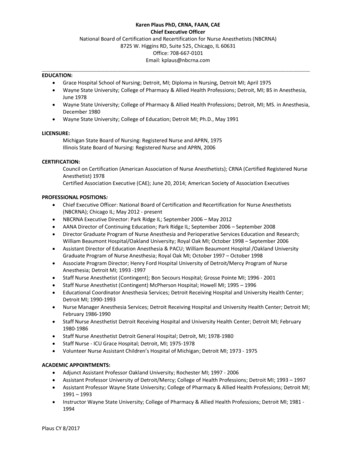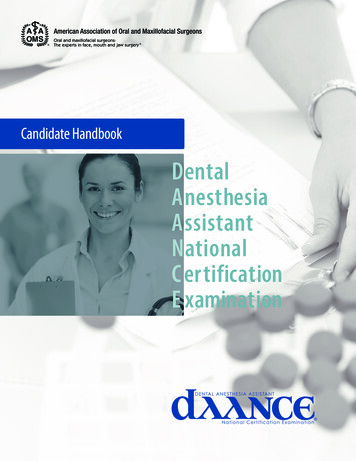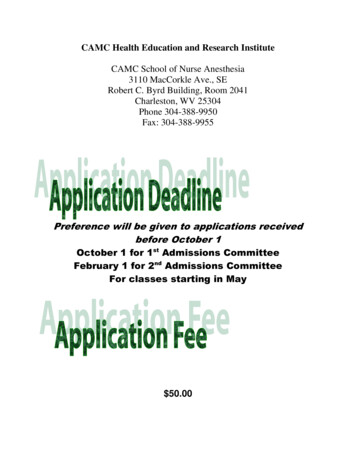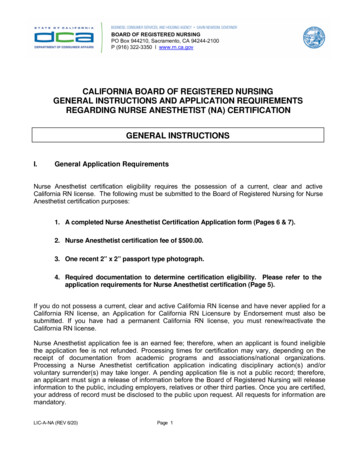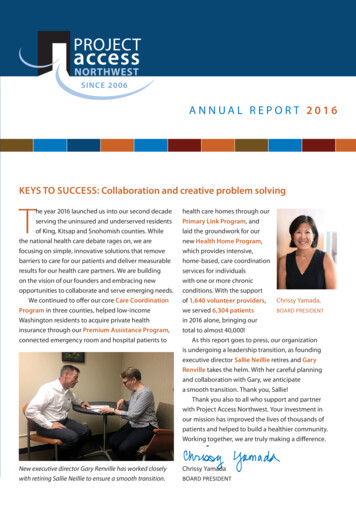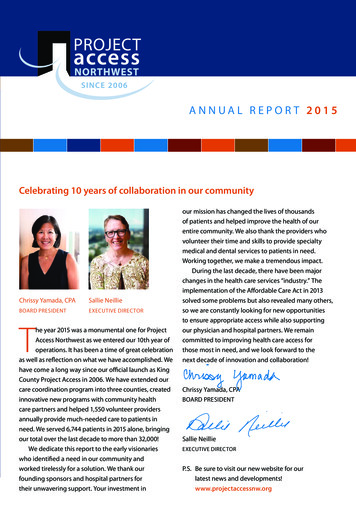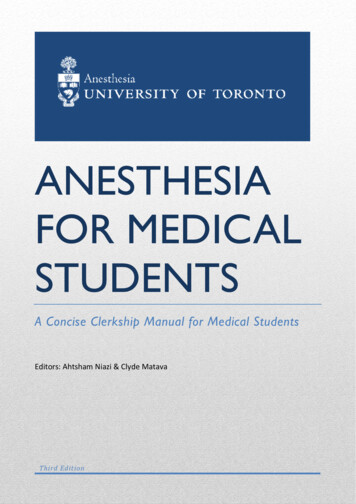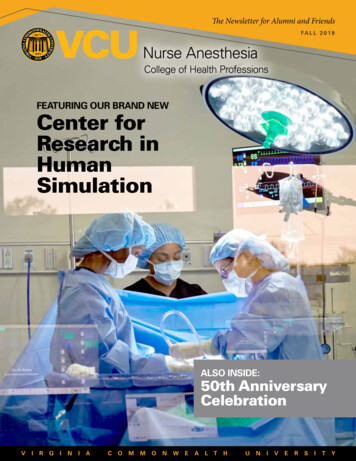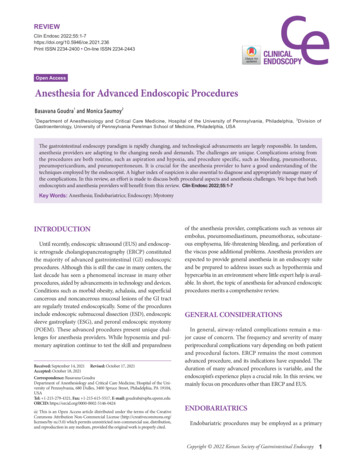
Transcription
REVIEWClin Endosc t ISSN 2234-2400 On-line ISSN 2234-2443Open AccessAnesthesia for Advanced Endoscopic ProceduresBasavana Goudra 1 and Monica Saumoy 21Department of Anesthesiology and Critical Care Medicine, Hospital of the University of Pennsylvania, Philadelphia, 2Division ofGastroenterology, University of Pennsylvania Perelman School of Medicine, Philadelphia, USAThe gastrointestinal endoscopy paradigm is rapidly changing, and technological advancements are largely responsible. In tandem,anesthesia providers are adapting to the changing needs and demands. The challenges are unique. Complications arising fromthe procedures are both routine, such as aspiration and hypoxia, and procedure specific, such as bleeding, pneumothorax,pneumopericardium, and pneumoperitoneum. It is crucial for the anesthesia provider to have a good understanding of thetechniques employed by the endoscopist. A higher index of suspicion is also essential to diagnose and appropriately manage many ofthe complications. In this review, an effort is made to discuss both procedural aspects and anesthesia challenges. We hope that bothendoscopists and anesthesia providers will benefit from this review. Clin Endosc 2022;55:1-7Key Words: Anesthesia; Endobariatrics; Endoscopy; MyotomyINTRODUCTIONUntil recently, endoscopic ultrasound (EUS) and endoscopic retrograde cholangiopancreatography (ERCP) constitutedthe majority of advanced gastrointestinal (GI) endoscopicprocedures. Although this is still the case in many centers, thelast decade has seen a phenomenal increase in many otherprocedures, aided by advancements in technology and devices.Conditions such as morbid obesity, achalasia, and superficialcancerous and noncancerous mucosal lesions of the GI tractare regularly treated endoscopically. Some of the proceduresinclude endoscopic submucosal dissection (ESD), endoscopicsleeve gastroplasty (ESG), and peroral endoscopic myotomy(POEM). These advanced procedures present unique challenges for anesthesia providers. While hypoxemia and pulmonary aspiration continue to test the skill and preparednessReceived: September 14, 2021Accepted: October 18, 2021Revised: October 17, 2021Correspondence: Basavana Goudra Department of Anesthesiology and Critical Care Medicine, Hospital of the University of Pennsylvania, 680 Dulles, 3400 Spruce Street, Philadelphia, PA 19104,USA Tel: 1-215-279-4321, Fax: 1-215-615-5517, E-mail: goudrab@uphs.upenn.edu ORCID: https://orcid.org/0000-0002-5146-0424This is an Open Access article distributed under the terms of the CreativeCommons Attribution Non-Commercial License (http://creativecommons.org/licenses/by-nc/3.0) which permits unrestricted non-commercial use, distribution,and reproduction in any medium, provided the original work is properly cited.of the anesthesia provider, complications such as venous airembolus, pneumomediastinum, pneumothorax, subcutaneous emphysema, life-threatening bleeding, and perforation ofthe viscus pose additional problems. Anesthesia providers areexpected to provide general anesthesia in an endoscopy suiteand be prepared to address issues such as hypothermia andhypercarbia in an environment where little expert help is available. In short, the topic of anesthesia for advanced endoscopicprocedures merits a comprehensive review.GENERAL CONSIDERATIONSIn general, airway-related complications remain a major cause of concern. The frequency and severity of manyperiprocedural complications vary depending on both patientand procedural factors. ERCP remains the most commonadvanced procedure, and its indications have expanded. Theduration of many advanced procedures is variable, and theendoscopist’s experience plays a crucial role. In this review, wemainly focus on procedures other than ERCP and EUS.ENDOBARIATRICSEndobariatric procedures may be employed as a primaryCopyright 2022 Korean Society of Gastrointestinal Endoscopy 1
treatment option or in patients who regained weight after aprevious bariatric surgical procedure. In some respects, thechallenges are similar, except that patients presenting for revisional procedures might have lost some weight. More important, patients who previously underwent weight loss surgerymay also have long-term complications, such as severe acid reflux. Clearly, anesthesia providers should be aware of all pathophysiological changes associated with obesity and the resultinganatomical changes. These changes affect pharmacology, bothin terms of dosing and clinical effects.The procedures employed as primary weight loss optionsare primary obesity surgery endoluminal (POSE), ESG, insertion of intragastric balloons, aspiration therapy with theAspireAssist device, and gastric botulinum toxin injection forweight loss. The revisional bariatric procedure that is typicallyperformed for endoluminal plication in patients who had undergone a Roux-en-Y gastric bypass is called transoral outletreduction (TORe). The gastric pouch can also be decreased insize, which is called tubular TORe or restorative obesity surgery endoluminal (ROSE). Other techniques include mucosalablation using argon plasma coagulation of the gastrojejunalanastomosis.1POSE uses an incisionless operating platform to createfull-thickness plications in the gastric fundus, thereby reducing gastric volume, which, in turn, limits the quantity of foodthat can be consumed at a given time.2 The procedure alsocauses antral dysmotility that prolongs satiety by inducingan earlier and longer feeling of gastric distention. In ESG,the endoscopist attempts to remodel the greater curvature ofthe stomach through the placement of full-thickness sutures.Similar to POSE, this results in reduced gastric capacity anddelayed gastric emptying.3,4 Originally, ESG was performedusing a superficial suction-based suturing device and had limited success owing to early suture loss. The current approachinvolves full-thickness suturing.Both POSE and ESG are time-consuming procedures performed under general endotracheal anesthesia (GETA). In addition to the general risks associated with any endoscopic procedures, such as hypoxemia and aspiration, there are specificrisks, including intraprocedural and postprocedural bleeding.Postprocedural pain could be substantial, requiring prolongedrecovery room stay and occasional overnight hospitalization.There is an increased risk of suture release with continuouspositive pressure application after the procedure. Pulmonarycompliance can decrease as a result of abdominal and gastricdistention due to carbon dioxide (CO2) leakage, whereasboth end-tidal CO2 (EtCO2) and pulmonary resistance mayincrease. Although the increase in EtCO2 can be addressed byincreasing minute ventilation, needle insertion into the perito-2neal cavity to release excess CO2 may be occasionally requiredfor treating pneumoperitoneum.Insertion of an intragastric balloon is typically performedunder deep propofol sedation, more commonly referred toas monitored anesthesia care (MAC). These balloons causeweight loss by inducing gastroparesis. Depending on the typeof balloon employed (either gas- or fluid-filled), they can beremoved under MAC or GETA. Fluid-filled balloons shouldbe removed under GETA because of the need to puncturethe balloon to release the large volume of saline to facilitateballoon removal. All balloons should be removed, as they canmigrate into the small bowel and cause obstruction.The AspireAssist device (Aspire Bariatrics Inc., King ofPrussia, PA, USA) functions similar to a percutaneous endoscopic gastrostomy tube and allows the aspiration of portionsof ingested food from the stomach. It has been approved by theFood and Drug Administration for use in patients with a bodymass index between 35 and 55 kg/m2.2 Both the insertion andremoval of this device are performed under deep sedation.Gastric injection weight loss therapy involves injecting botulinum toxin into the smooth muscle of the gastric fundusto induce gastroparesis and early satiety. This is an effectiveweight-loss therapy in combination with diet and exercise. Theprocedure is performed under deep sedation.Revisional endobariatric procedures such as TORe andROSE utilize an endoscopic suturing device (Overstitch;Apollo Endosurgery, Austin, TX, USA) in patients who hadundergone Roux-en-Y gastric bypass to narrow the gastrojejunal anastomosis and to decrease the size of the gastric pouch.These procedures are performed under GETA. Argon plasmacoagulation involves the application of argon laser coagulationto the anastomotic outlet. Deep sedation is usually sufficient.Multiple sittings are needed, with each sitting taking approximately 15 min.Postoperative nausea and vomiting (PONV) can be a troubling complication of all endobariatric procedures. Aggressivepharmacotherapy has been used to limit PONV. Additionally,postprocedural pain may be substantial, particularly afterfull-thickness plication procedures. However, unlike bariatricsurgery procedures, endoscopic procedures do not typicallyrequire hospital admission for monitoring, pain management,or nausea control.At the Hospital of the University of Pennsylvania, our experience is with TORe, which is performed in our outpatientfacility. Anesthesia is induced with propofol and fentanyl andmaintained with infusions of propofol and remifentanil (an ultrashort-acting opioid). In morbidly obese patients, the dosesof both propofol and remifentanil are lower than the standardadult doses (e.g., propofol bolus of 1.5–2 mg/kg body weight
Goudra B et al. Advanced Endoscopy Anesthesiafor induction). The infusions of both propofol and remifentanil are also considerably lower (approximately one-half) thanthose used for anesthesia maintenance in a normal-weight oroverweight patient, approximately 70–100 μg/kg/min propofoland 0.1–0.12 μg/kg/min remifentanil. Blood pressure supportoften requires phenylephrine at approximately 30 μg/min.Because of the increased risk of PONV, we avoid inhalationalanesthetics. Intermittent positive pressure ventilation (IPPV)is always employed, and the settings are adjusted to maintainan acceptable EtCO2. The effect of rocuronium is reversedusing sugammadex. Ondansetron is routinely administered,and dexamethasone is sometimes used for PONV prophylaxis. Postprocedural pain could be substantial, and patientsare maintained in the recovery room for about 1 hour beforebeing discharged home.POEMPOEM is performed to treat achalasia, a motility disorderof the esophagus. Gastroenterologists often misdiagnose thecondition as gastroesophageal reflux disease. The absence ofrelaxation of the lower esophageal sphincter is a characteristicfeature of achalasia. Nevertheless, this is not essential for diagnosis and is not always present.5 The surgical treatment for thiscondition is a Heller myotomy, in which the anterior musclefibers of the esophagus are incised longitudinally.6 Laparoscopic or thoracoscopic approaches, including laparoendoscopicsingle-site surgery and robot-assisted myotomy, and POEM,have largely replaced open surgery.7The preprocedural evaluation of patients presenting forPOEM should specifically focus on the increased risk of aspiration. The clinical presentation depends on the subtype ofachalasia. Three subtypes are recognized: type I (classic), withminimal contractility in the esophageal body; type II, withintermittent periods of panesophageal pressurization; andtype III (spastic), with premature or spastic distal esophagealcontractions. Progressively worsening dysphagia initially tosolids, followed by both solids and liquids, is the leading presentation.8 Severe reflux, history of regurgitation, pneumonia,and weight loss are signs of possible preprocedural/intraprocedural aspiration. Aspiration pneumonitis (acute and chronic),diffuse aspiration bronchiolitis, isolated bronchospasm, andaspiration pneumonia can occur in these patients. Chronicinterstitial fibrosis is conceivable over a period of time and isrelated to periodic aspiration.9In terms of anesthetic management, GETA is required forPOEM.10 Extended fasting time is often required (up to 48 h,depending on the degree of symptomatology, previous esoph-agogastroduodenoscopy [EGD] findings, and manometricstudies) to minimize the risk of aspiration. Rapid sequenceinduction and intubation, often in a slight head-up position,has the least risk of aspiration. Even though suuden airwayobstruction is rare, it can be caused by tracheomalacia, relatedto posterior tracheal cartilage ischemic damage resulting fromchronic pressure due to massive esophageal dilation. The collapse is dynamic in nature, which can be relieved by IPPV withpositive end-expiratory pressure. Cuffed reinforced endotracheal tubes are preferred to avoid kinking or obstruction of theendotracheal tube during endoscopy. In addition to standardmonitoring, neuromuscular monitoring to ensure an appropriate degree of paralysis is essential. An increase in EtCO2 isanticipated and attributed to the use of CO2 by the endoscopistand its absorption. Any unexpected movement will not beappreciated by the endoscopist and should be avoided. Theavailability of sugammadex allows an anesthesia provider toerr on the side of caution rather than risk inadequate paralysis.The procedure itself involves making a mucosal incision in themid-esophagus, entering it, and creating a submucosal tunnelall the way to the gastric cardia by using a forward-viewing endoscope with a transparent distal cap and an ESD knife. Oncethe muscle fibers are exposed, they are incised and the mucosal incision is closed with endoscopic clips.11Intraprocedural complications include pneumothorax,mediastinal emphysema, subcutaneous emphysema, pneumoperitoneum, and, rarely, capnopericardium. To diagnose thesecomplications, a high degree of suspicion is necessary.12 Thepostprocedural period may be complicated by delayed hemorrhage, pleural effusion, minor inflammation or segmentalatelectasis of the lungs, and gas under the diaphragm or aeroperitoneum.Nearly 25% of patients undergoing POEM experience asymptomatic pneumothorax, especially when the procedureis performed under GETA. Positive pressure ventilation increases the air escape. Dissection of the thoracic portion ofthe esophagus and the resulting mediastinal pleural tear arethe likely causes. Clearly, the use of air for insufflation must beavoided, which, despite potentially providing better distensionand more manipulative space, is also associated with highermorbidity and mortality than the use of CO2.Although a rare complication, capnopericardium can causecardiac arrest. Disappearing EtCO2 tracing or pulse tracingon a plethysmogram may be the first indicators of capnopericardium. Blood pressure may be nonrecordable, and electrocardiogram changes might appear, including life-threateningarrhythmias. Immediate suspension of the procedure andendoscope withdrawal along with cardiopulmonary resuscitation may be required. Transthoracic echocardiography may3
not adequately image the heart. The procedure may need to beaborted, as any suturing of the mucosal incision might worsenthe capnopericardium.Subcutaneous emphysema is another known complication.There may be a palpable crepitus. CO2 insufflation may become challenging with both flow and pressure. An increase inEtCO2 may be noticed along with respiratory acidosis duringblood gas measurement. Lung compliance will decrease (withincreased airway pressure) along with sinus tachycardia andother cardiac arrhythmias. An increase in blood pressure isthe likely result of an increase in partial CO2 50 mm Hg.13Decompression by inserting a 14- or 16-gauge angiocatheterin the right lower abdomen, approximately 5 cm below thecostal margin, preferably guided by ultrasound, may becomenecessary. The presence of air in the mediastinum may notpose considerable clinical challenges and is typically observedalong with subcutaneous emphysema. An increase in EtCO2, adecrease in saturation of peripheral oxygen (SpO2), and inability to archive the desired tidal volume despite maximal safelyattainable manual ventilation are key indicators of pneumomediastinum. The endoscope should be withdrawn, and thepatient should be evaluated. Malignant hyperthermia shouldbe excluded, although difficulty in ventilation and lack of hyperthermia can eliminate such a possibility. Acidosis will beseen on arterial blood gas, despite the administration of 100%oxygen. Hypotension, cardiac arrhythmia, and hemodynamiccollapse are possible. Chest radiography might demonstratevariable pneumomediastinum and subcutaneous emphysema.De-aeration might become necessary and can be accomplished with a percutaneous abdominal needle along withpositive pressure ventilation with suitable ventilator settings.14All of the above complications may appear for the firsttime in the postprocedural period. At our hospital, patientspresenting for POEM fast longer than usual and stay on clearfluids for 48 hours. We used to perform this procedure in ourinpatient facility; however, after gaining more experience, wenow perform about half of such procedures in our outpatientfacility and the patients are usually discharged the next day.General anesthesia with propofol and fentanyl (generally 2–3mg/kg and 100–150 µg, respectively), followed by intubationfacilitated with either succinylcholine or rocuronium (usually100 mg for both) as a rapid sequence induction intubationtechnique, is used. Anesthesia is maintained with propofol–remifentanil (infusion at 120–150 µg/kg/min and 0.2–0.25 µg/kg/min, titrated). CO2 accumulation is inevitable, and highertidal volumes during IPPV are often needed. The incidence ofPONV is higher than that with routine EGD, and prophylaxiswith ondansetron is a standard practice. The procedure usually takes 1–2 hours.4ESDESD can be performed for en bloc resection of early GIluminal cancers. This procedure is performed on localizedlesions with a minimal risk of metastasis.15,16 Unlike endoscopic mucosal resection, which can only remove lesions in apiecemeal fashion, ESD is intended to treat larger lesions withen bloc resection to assess the tumor-free margins. As a result,this procedure has a higher rate of complications, such as perforation causing peritonitis and delayed bleeding.The endoscopist expects a relatively motionless andwell-sedated patient. At our center, for lesions in the lower GItract, ESD is generally performed under deep sedation withpropofol. Occasionally, the procedure can take 2–3 hours. Ashort-acting opioid, such as fentanyl, is often required in increments and may contribute to longer recovery and postprocedural stays.However, for upper GI lesions, GETA is preferred becauseof the risk of intraprocedural bleeding. It also ensures a stableworking field without rapid or unexpected movements. Ithas been reported that the rate of curative resection is betterand the perforation rate is lower in ESD performed underGETA than in ESD performed under conscious sedation afteradjusting for several clinicopathologic factors, including theexperience of the endoscopist, thereby improving oncologicoutcomes in patients with superficial esophageal squamouscell carcinoma.16At our hospital, general anesthesia with an endotrachealtube is always employed for ESD procedures. The inductiondoses of propofol and fentanyl are similar to those used inPOEM; however, rapid sequence induction is not generallyrequired. The maintenance of anesthesia is also similar. Theprocedure takes approximately 1–2 hours, and occasionallylonger, depending on the size of the lesion. CO2 accumulationrequires a higher tidal volume with IPPV. PONV prophylaxiswith ondansetron is a standard practice. Postprocedural painmanagement may require an overnight stay.ERCPERCP is a routine advanced procedure performed in manyacademic and freestanding endoscopy units. Although theissue of airway management is still unsettled, the choice islargely left to the institution and the individual anesthesia provider. Other reviews on this topic have extensively discussedthe related issues.17,18Cases of fatal and nonfatal air embolisms during ERCPhave been reported.19-24 Other procedures such as EGD, EUS,colonoscopy, or sigmoidoscopy have also been associated with
Goudra B et al. Advanced Endoscopy Anesthesiaair embolism.25,26 A high index of clinical suspicion is requiredfor diagnosis, and aggressive treatment is needed to avoid afatal outcome. The use of precordial Doppler ultrasound andtransesophageal echocardiography is helpful for establishing adiagnosis of air embolism. Besides traditional supportive measures, hyperbaric oxygen therapy should be considered in cases of suspected cerebral air embolism to improve neurologicaloutcomes. Air embolism can also manifest for the first timeafter the procedure. A case of ventricular fibrillation requiringprolonged cardiopulmonary resuscitation and resulting indeath in the recovery room has been reported.19 As previouslystated, it is crucial that CO2 is used for advanced endoscopicprocedures such as ERCP to decrease the risk of air embolism.At our hospital, 90% of ERCP procedures (including nearly 100% of procedures in the outpatient center) are performedunder anesthesiologist (who is always a physician)-superviseddeep propofol sedation administered by a certified nurseanesthetist. Propofol and fentanyl are typically administered as80–100 mg and 25–50 µg boluses, respectively, followed by theinfusion of 80–120 µg/kg/min propofol. The patients breathespontaneously, and supplemental oxygen is generally administered through a nasal trumpet introduced into the nose ormouth (Fig. 1).facility, although they can also be performed in an outpatientfacility.Ultrasound-guided drainage of pancreatic cysts, includingpseudocysts, may be performed under deep sedation if thecysts are small and have a negligible risk of pulmonary aspiration resulting from the leak/flooding of the stomach. However,most pseudocysts that require drainage are large and containa large volume of fluid that will be released into the GI lumen.As there is a risk of pulmonary aspiration with large cysts,GETA tube is advisable.Patients with infected peripancreatic walled-off necrosis collections will also require drainage and multiple sessions of direct endoscopic necrosectomy. Patients with severe necrotizingpancreatitis can develop a well-demarcated, organized collection of necrotic tissue.27 A transgastric stent can be placed intothe collection to facilitate direct endoscopic necrosectomy forthe endoscopic debridement of this collection. This approachis known to result in a lower incidence of new-onset multiorgan failure and a lower major complication rate than surgicalnecrosectomy. In contrast to open surgical necrosectomy,direct endoscopic necrosectomy is associated with lower ratesof complications such as bleeding and inadvertent puncture ofthe adjacent viscera, as well as with a decreased risk of chronicpancreaticocutaneous fistulae. This procedure is always performed under GETA.We recognize that the anesthesia/sedation practice foradvanced procedures, especially ERCP, varies worldwide. Inmost countries (outside the United States), the majority ofERCP and EUS procedures are performed either with intravenous conscious sedation or a registered nurse (not a nurseanesthetist)-administered propofol sedation. Generally, thepropofol doses are lower. As a likely result, the satisfaction ofboth endoscopists and patients is lower. Nonetheless, the prac-EUS-GUIDED DRAINAGE OFPERIPANCREATIC COLLECTIONSEUS-guided drainage of large pancreatic pseudocysts andpancreatic walled-off necrosis to allow for transgastric necrosectomy are rare procedures. These procedures are performedin patients with pancreatitis and typically in an inpatientReservoir bagNasal trumpetEnd tidal oxygen sampling tubePressure limiting valveElbow connectorElbow connectorCorrugated tubeHeat moisture exchangerOxygen tubingFig. 1. Mapleson C breathing system in use in a obese patient undergoing esophageal dilation with propofol deep sedation.5
Fig. 2. Head tilt–chin lift and jaw-thrust maneuvers in use to restore upper airway patency.tice is safe and, in fact, a meta-analysis has shown it to be saferthan physician anesthesiologist-administered propofol sedation.28 For the advanced procedures discussed here, with theexception of uncomplicated ERCP and EUS, we recommendthat the sedation be administered or supervised by an anesthesiologist.Irrespective of the person administering the sedation, adverse events such as desaturation are inevitable. The mostcommon causes of desaturation are hypoventilation (as aresult of sedative medications) and upper airway obstruction. An attentive clinician/nurse will be able to recognize thecause. The corrective measures depend on the cause. Airwayobstruction often responds to measures such as chin lift, jawthrust, and neck extension – maneuvers often not employed oremployed late (Fig. 2). The oxygen flow should be immediately increased to 10–15 L/min. If these measures are ineffective,the endoscopist must withdraw the endoscope, and bag maskventilation should begin in earnest. If laryngospasm is recognized, the short-acting muscle relaxant succinylcholine shouldbe administered at approximately 25–50 mg, early than late.Certain factors increase the risk of hypoventilation and airwayobstruction. Elderly patients are particularly susceptible to hypoventilation, even with small doses of sedative medications.Smokers, obese individuals, those with obstructive sleep apnea, patients with chronic obstructive pulmonary disease, andthose recovering from a recent upper respiratory infection aresusceptible to upper airway obstruction, whereas patients withasthma are predisposed to bronchial obstruction.CONCLUSIONSIn conclusion, advanced GI endoscopic procedures continue to evolve and pose many unique challenges to the anesthe-6sia provider. Endoscopists are also likely to be in a “learningmode” during the early stages of the introduction of these procedures in their procedure settings. A discussion between theanesthesia provider and the endoscopist is crucial to recognizethe risks and preempt them. As always, the team should beprepared to manage both expected and unexpected adverseevents.Conflicts of InterestThe authors have no potential conflicts of interest.FundingNone.Author ContributionsConceptualization: Basavana Goudra, Monica SaumoyData curation: BG, MSWriting-original draft: BG, MSWriting-review&editing: BG, MSORCIDBasavana GoudraMonica /orcid.org/0000-0003-2780-1206REFERENCES1. Goh YM, James NE, Goh EL, Khanna A. The use of endoluminal techniques in the revision of primary bariatric surgery procedures: a systematic review. Surg Endosc 2020;34:2410-2428.2. Tawadros A, Makar M, Kahaleh M, Sarkar A. Overview of bariatricand metabolic endoscopy interventions. Ther Adv Gastrointest Endosc2020;13:2631774520935239.3. de Moura DTH, de Moura EGH, Thompson CC. Endoscopic sleevegastroplasty: from whence we came and where we are going. World JGastrointest Endosc 2019;11:322-328.4. Jain D, Bhandari BS, Arora A, Singhal S. Endoscopic sleeve gastroplasty- a new tool to manage obesity. Clin Endosc 2017;50:552-561.
Goudra B et al. Advanced Endoscopy Anesthesia5. Fox M, Hebbard G, Janiak P, et al. High-resolution manometry predictsthe success of oesophageal bolus transport and identifies clinically important abnormalities not detected by conventional manometry. Neurogastroenterol Motil 2004;16:533-542.6. Torres-Villalobos G, Martin-Del-Campo LA. Surgical treatment forachalasia of the esophagus: laparoscopic Heller myotomy. GastroenterolRes Pract 2013;2013:708327.7. Goudra B, Singh P, Green M. Anaesthesia for uncommon and emergingprocedures. New York (NY): Springer; 2021.8. Patel DA, Lappas BM, Vaezi MF. An overview of achalasia and its subtypes. Gastroenterol Hepatol (NY) 2017;13:411-421.9. Ali HA, Murali G, Mukhtar B. Respiratory failure due to achalasia cardia. Respir Med CME 2009;2:40-43.10. Goudra B, Singh PM, Gouda G, Sinha AC. Peroral endoscopic myotomy-initial experience with anesthetic management of 24 procedures andsystematic review. Anesth Essays Res 2016;10:297-300.11. Pandolfino JE, Kahrilas PJ. Presentation, diagnosis, and management ofachalasia. Clin Gastroenterol Hepatol 2013;11:887-897.12. Ren Z, Zhong Y, Zhou P, et al. Perioperative management and treatment for complications during and after peroral endoscopic myotomy(POEM) for esophageal achalasia (EA) (data from 119 cases). Surg Endosc 2012;26:3267-3272.13. Bang Y-S, Park C. Anesthetic consideration for peroral endoscopic myotomy. Clin Endosc 2019;52:549-555.14. Okada T, Izuta S, Mizobuchi S. A case of ventilatory impairment duringper-oral endoscopic myotomy under general anesthesia. JA Clin Rep2018;4:23.15. Kiriyama S, Naitoh H, Kuwano H. Propofol sedation during endoscopictreatment for early gastric cancer compared to midazolam. World J Gastroenterol 2014;20:11985-11990.16. Song BG, Min YW, Cha RR, et al. Endoscopic submucosal dissectionunder general anesthesia for superficial esophageal squamous cell carcinoma is associated with better clinical outcomes. BMC Gastroenterol2018;18:80.17. Goudra B, Singh PM. ERCP: the unresolved question of endotrachealintubation. Dig Dis Sci 2014;59:513-519.18. Basavana G. Goudra, Michael Duggan, Vidya Chidambaran, et al. Anesthesiology: a practical approach. New York (NY): Springer; 2018.19. Hauser G, Milosevic M, Zelić M, Stimac D. Sudden death after endoscopic retrograde cholangiopancreatography (ERCP)--case report andliterature review. Medicine (Baltimore) 2014;93:e235.20. Wanderer JP, Nathan N. Bubble trouble: venous air embolism inendoscopic retrograde cholangiopancreatography. Anesth Analg2018;127:324.21. Marchesi M, Battistini A, Pellegrinelli M, Gentile G, Zoja R. Fatal airembolism during endoscopic retrograde cholangiopancreatography(ERCP): an
the viscus pose additional problems. Anesthesia providers are expected to provide general anesthesia in an endoscopy suite and be prepared to address issues such as hypothermia and hypercarbia in an environment where little expert help is avail - able. In short, the topic of anesthesia for advanced endoscop
